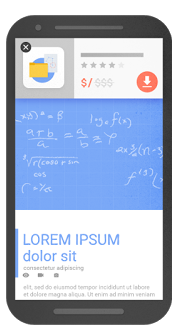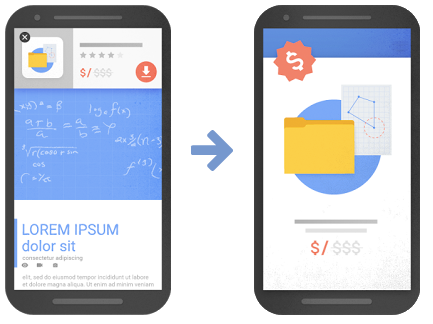Changes to Google Mobile Search Policy: Understanding its Implication
Given user’s search habits and the rise of mobile use, Google has announced a recent change that will have an impact on your mobile search rankings, particularly if you are using interstitials on mobile pages that make content less accessible for mobile users. This change is intended to make sure that content is easier to find on mobile devices.
In the interest of ensuring optimum user quality and experience, these changes are meant to minimize potential issues one might face upon arriving to a site after searching for it. It specifically targets the use of popups that appear as soon as you arrive on the site, blocking the content users are looking for.
In this post, we will elaborate on:
- What are the changes?
- What are Interstitials?
- Examples of interstitials that make content less accessible (According to google)
- Examples of interstitials that would not be affected by the new signal (According to google)
- Will your mobile search ranking be affected?
- Techniques to make sure you are not impacted by the google’s new signal
- Conclusion
What are the changes?
Google is introducing a new signal to its mobile search results which will come into effect after January 10, 2017. After this change, mobile pages with interstitials, where content is not easily accessible to a user on the transition from the mobile search results may not rank as highly.
What are Interstitials?
Interstitials are full-screen ads/popups/overlays that block the website’s other content. They often are on the screen for a select number of seconds or until a “x” button is clicked by user.
Pros: Interstitial ads overcome mobile’s biggest hurdle – limited real estate – by consuming the entire screen. Unlike banner ads, interstitials force users to interact by clicking out or clicking through the ad. Due to these actions, interstitials grab users’ attention and maintain high conversion rates.
Cons: Interstitial ads blocks users from accessing the content by forcing user to take desired action or close the interstitial by clicking on ‘x’.
Examples of interstitials that make content less accessible (According to google)
Below are some examples of techniques that make content less accessible to a user according to Google
- Showing a popup that covers the main content, either immediately after the user navigates to a page from the search results, or while they are looking through the page.
- Displaying a standalone interstitial that the user has to dismiss before accessing the main content.
- Using a layout where the above-the-fold portion of the page appears similar to a standalone interstitial, but the original content has been inlined underneath the fold.

Image Credit: Google
Examples of interstitials that would NOT be affected by the new signal, if used responsibly (According to google)

Image Credit: Google
- Interstitials that appear to be in response to a legal obligation, such as for cookie usage or for age verification.
- Login dialogs on sites where content is not publicly indexable. For example, this would include private content such as email or unindexable content that is behind a paywall.
- Banners that use a reasonable amount of screen space and are easily dismissible. For example, the app install banners provided by Safari and Chrome are examples of banners that use a reasonable amount of screen space.
Now the question is—will your mobile search ranking be affected?
Yes, Only If you are using interstitials on mobile pages that prevent visitors to reach your primary content from search. (Please refer examples of interstitials that make content less accessible above)
Having said that, the extent of the impact remains to be seen. We will be doing a further analysis of its actual impact once the changes are rolled out early next year.
As quoted in google announcement:
“This new signal (interstitials on mobile) is just one of hundreds of signals that are used in ranking. The intent of the search query is still a very strong signal, so a page may still rank highly if it has great, relevant content.”
Techniques to make sure you are not impacted by the google’s new signal
Technique 1: Replace your interstitials with banners that use a reasonable amount of screen space and are easily dismissible.

Image Credit: Google
Technique 2: Replace your interstitials with a multi-step campaign, In step 1 show a banner, when user clicks on the banner display interstitials for the desired action. This way you will not be blocking the content either immediately or while they are looking through your mobile page.

Show your CTA in a banner, when user clicks on banner show detailed offer in a popup overlay.
Technique 3: Replace your interstitials with combination of banner and mobile optimized squeeze page. when user clicks on the banner you redirect them to a mobile optimized squeez page to take the desired action.

Show your CTA in a banner, when user clicks on banner redirect user to a landing page with detailed offer.
Conclusion
Generally, if you’ve ensured that your site delivers good content and offers a good user experience, this isn’t really something that you have to worry about.
And for the use of interstitials on pages, the key thing to remember here is that the sites that will be penalized by this change likely have poor user experience to begin with. These are the kind of popups that are triggered as soon as visitors arrive on the site, blocking content that users are searching for.
The important thing to remember is that you make sure that your users are able to reach, find and consume your primary content upon arriving on your site after they searched for it.
That said, here are some more ways you can make sure that your site doesn’t get affected by these changes—
- Make sure that your website is completely mobile-friendly.
- Make sure that you are consistently providing high quality, relevant content to your visitors to keep your search rankings high.
- Avoid using mobile popups/overlays on the important pages of your mobile website that ranks high in google searches.
- Replace mobile popups/overlays with other mobile friendly notifications which take reasonable screen space such as banners.
- Avoid triggering mobile popups/overlays immediately when a user arrives to your mobile page.
- Give your users time to review your actual content before you allow popups to appear or trigger it when user has become inactive on your page.
- Ensure that your pops are offered within context and provide relevant and valuable content.
Keep in mind that this new signal is just one among numerous other factors that go into your ranking, but it’s important nonetheless.
If you have any questions or clarifications, Please leave a comment below.
Existing customers please get in touch with us, so that we can help you make changes to your mobile campaigns to ensure that you are not penalized by google’s new signal.
Share This Story
Get the latest growth ideas, strategies, and best practices delivered to your inbox.
Quick read that helps 7000+ subscribers.








